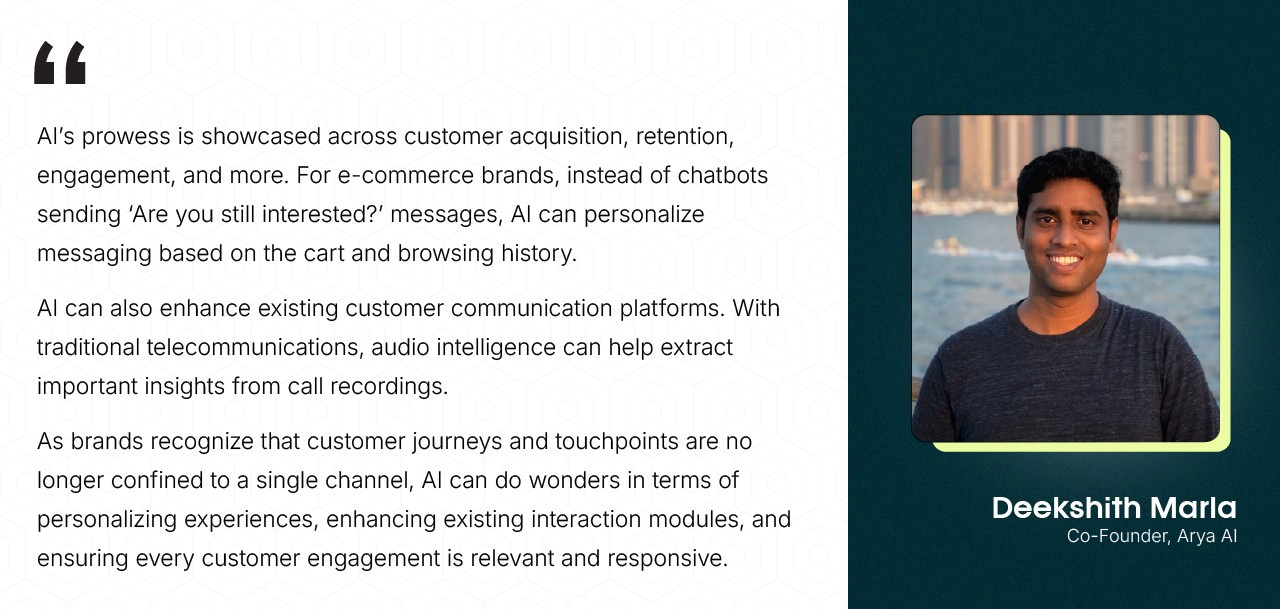Customer Experience (Enhancement & Personalization)
Hello! Welcome to the latest edition of Fin AI Briefings. This time, we’ll delve into how AI can enhance and personalize customer experiences.
In BFSI, customer experience is key to business success and maintaining brand loyalty. Delivering exceptional CX stands a critical challenge, where customer service interaction is a huge bottleneck and in need of significant improvement.
Poor CX is one of the key causes of customer dissatisfaction and attrition, which means banks and financial institutions are in dire need of a viable solution! That is where AI comes into the equation.
With the help of AI-powered systems, BFSI organizations can deliver tailored customer experiences. AI in onboarding ensures customers are onboarded without friction, Gen AI-powered chatbots provide contextually relevant responses 24*7, and analysis of vast datasets helps with hyper-personalization.
In a nutshell, artificial intelligence represents a paradigm shift in how BFSI organizations deliver customer experience. We’ll explore this and a lot more in this edition of the newsletter.
Simple or Complex Customer Service? It's More Complex Than That [Nick Clark]
Many customer service strategies assume requests can be classified as simple or complex from the start. However, real interactions show that needs often shift between both. A rigid approach fails when unexpected issues arise. Instead of fixed "journeys," businesses should adopt flexible "pathways" that adapt in real time.
Where AI Voice Agents Fail the Most Today [Davit Baghdasaryan]
AI voice agents struggle with turn-taking (knowing when to talk and when to listen), especially in noisy environments. Voice Activity Detection (VAD) alone is too basic, leading to false interruptions. Integrating noise and voice cancellation improves accuracy, reducing interruptions by 71% and increasing CSAT by 30%.
AI-Powered CX: Agentic AI in Hyper-Personalization and Automation [On_the_Sunny Side]
Agentic AI redefines customer experiences by enabling AI assistants to think and act proactively, bridging the gap between automation and humanlike decision-making. Unlike traditional AI, these systems learn, anticipate needs, and adapt dynamically. Concerns around data security, misuse, and privacy remain key challenges as AI becomes more autonomous.
Mastering the Six Pillars: How AI-Driven Customer Experience Secures Sustainable Success [Martino Agostini]
Delivering exceptional Customer Experience (CX) through the Six Pillars: Personalization, Integrity, Expectations, Resolution, Time and Effort, and Empathy. It highlights that responsibly leveraging AI can enhance these areas, leading to deeper customer connections, increased loyalty, and improved financial performance.
Audio Intelligence: The Future of Analyzing Conversational Audio [Arya AI]
Audio intelligence analyze audio data for better decision-making. It includes components like speech-to-text, sentiment analysis, and speaker identification. Despite challenges in privacy, speech diversity, and real-time processing, the future promises more personalized, multilingual, and emotion-aware systems.
Chatbot vs Conversational AI vs AI Agent — What’s the Difference? [Mohammed Rafique Maricar]
Chatbots, conversational AI, and AI agents differ in complexity and capabilities. Chatbots follow pre-set scripts for simple queries, while conversational AI uses NLP and machine learning for more natural, adaptive interactions. AI agents go further, making decisions and executing tasks autonomously.
Journey-Based Activations for BFSI [Karel Holub]
Journey-based audience activation uses real-time behavior signals to target customers based on their current needs. This approach enables FIs to recover abandoned applications, boost conversions with personalized offers, cross-sell relevant products, and prevent churn with proactive engagement.
How AI Agents are Opening the Golden Era of Customer Experience [BCG]
The convergence of AI agents and innovative hardware promises superior customer experience at lower costs. As companies integrate autonomous agents and next-gen devices, they can deliver personalized, seamless interactions. Leaders should start with deep initiatives to test AI use cases, build for customer missions, and focus on converging teams, tech, and skills.
How Bank CIOs Can Build a Solid Foundation for Generative AI [Bain and Company]
Banks must adopt a strategic approach that involves building a clear roadmap for use cases, investing in data architecture and cloud technologies, and managing the costs and risks of AI deployment. To succeed, banks need a well-defined strategy, cross-functional collaboration, and a shift in talent and organizational culture to fully harness the potential of generative AI.
👉🏼 Article: Agentic AI and Personalized Shopping Experiences Will Dominate 2025 [PYMNTS]
👉🏼 Article: Build vs. Buy - Navigating the AI Agent Dilemma in BFSI [Arya AI]
👉🏼 Podcast: Waymo's Foundation Model for Autonomous Driving with Drago Anguelov [The TWIML AI Podcast with Sam Charrington]
👉🏼Article: The Future of Personalized Finance: How AI is Tailoring Financial Services to Individual Needs [Finextra]
👉🏼 Article: Edge AI in Finance [Arya AI]
👉🏼 Newsletter: What does GPT-4o's Native Image Gen Mean for Art, Artists, and AI Adoption? [Towards AI]
👉🏼 Podcast: Vertical AI Agents Could Be 10X Bigger Than SaaS [Y Combinator]
👉🏼 Article: Empowering AI Agents with Real-Time Data [Gradient Flow]
We hope you enjoyed reading this edition of Fin AI Briefings. Let us know in the comments if you did! Click the Subscribe button for the new issue.





